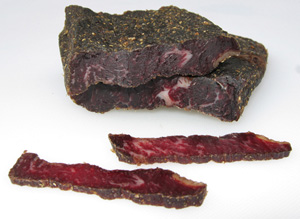Meats and Sausages
Biltong
Biltong is South African dried meat. In 1652 the Dutch settlers came to the Cape of Good Hope and established a new country. The name biltong originates from the Dutch word Bil meaning buttock and Tong meaning strip. Biltong is not "beef jerky" and it is made by salting, spicing and curing selected cuts of beef, venison, kudu, springbok or ostrich.
| Procedure | Jerky | Biltong |
|---|---|---|
| Heat applied | Yes | No |
| Vinegar | No | Yes |
| Smoked | Optional | No |
| Air dried | Yes | Yes |
| Note: biltong cuts are usually bigger and thicker than jerky. If you live in a warm, moist climate cut your strips of meat thin. The thicker the meat, the longer it will take to dry out, and the higher the risk to spoilage. | ||
A home made biltong will usually be made from the beef buttock. Great cuts are sirloin and steaks cut from the hip such as topside or silverside. The best biltong is made from the eye of the round muscles that run down both sides of the backbone. Ideally the meat is marinated in a vinegar solution (cider vinegar is traditional but balsamic also works very well) for a few hours, and finally poured off before the meat is flavored. Coriander is the dominant spice.
Drying equipment. Drying jerky presents less of a problem than drying salami as the strips are much smaller and can be dried fast. Controlling humidity is not an issue. Quality salami has to dry slow in order to give time for flavor forming bacteria to react with proteins and fats. Jerky flavor is set by meat quality and the marinade. You can dry meat strips in a dehydrator, kitchen oven with the pilot light on, in the open air or in boxes and improvised containers. When drying jerky outside, cover openings with porch plastic screening fabric that is cheap, comes in a roll and can be easily cut. This will keep insects away. Remember to make holes at the bottom and the top of the box to create a natural draft. The bigger the height difference between the bottom and top holes, the stronger the draft.
You can build the wooden frame with supports for drying racks and hanging sticks and cover the sides and top with screening fabric. For starters even a cardboard box will do. If electricity is available you can place a light bulb (60 - 100 W) in the bottom to supply heat. Make a little shield over the light as the dripping grease might burst into flames. A little computer fan (described in the chapter on fermented sausages) will provide ample ventilation.














